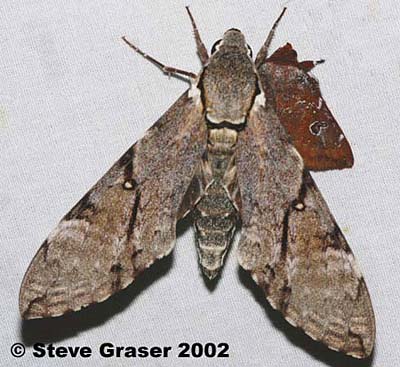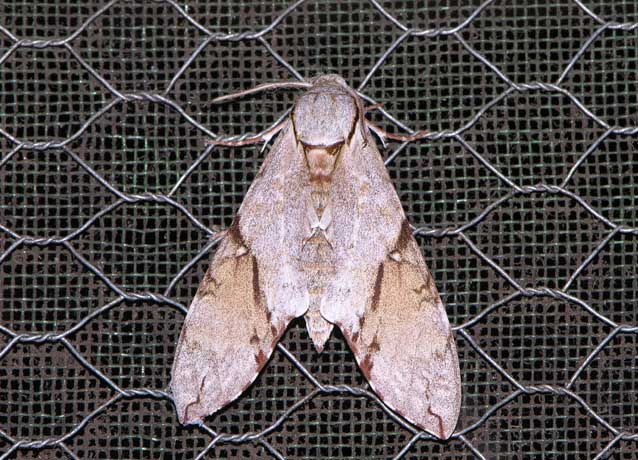Manduca prestoni
|
|
Updated as per personal communication with Johan van't Bosch (Mato Grosso, Brazil, September 20, March 22), March 2008
Updated as per French Guiana Sphingidae; March 9, 2011
Updated as per CATE (description; Ecuador, Bolivia, Brazil); February 12, 2011
Updated as per personal communication with Ezequiel Bustos (Shilap revta. lepid. 43 (172) diciembre, 2015, 615-631 eISSN 2340-4078 ISSN 0300-5267), January 4, 2016
|
Manduca prestoni
(Gehlen, 1926) Protoparce

Manduca prestoni copyright, courtesy of Steve Graser,
Yasuni, Ecuador, September 11, 2002 - 12:34 AM
This site has been created by Bill Oehlke.
Comments, suggestions and/or additional information are welcomed by Bill.
TAXONOMY:
Family: Sphingidae, Latreille, 1802
Subfamily: Sphinginae, Latreille, [1802]
Tribe: Sphingini, Latreille, 1802
Genus: Manduca Hubner, [1807] ...........
Species: prestoni (Gehlen, 1926)
|
DISTRIBUTION:
Manduca prestoni (males: 112mm; females: 125mm)
flies in
Brazil: Amazonas (specimen type locality); Manicore;
Ecuador;
French Guiana: SGO Regina; and in
Bolivia: Santa Cruz: Andrés Ibáñez, Potrerillos del Güendá.
Johan van't Bosch reports it from Mato Grosso, Brazil.
Ezequiel Bustos indicates it has also been taken in Argentina: Tucuman, and that it is likely also present in Salta and Jujuy.
"Very similar to Manduca lefeburii, but the forewing upperside transverse dark band that runs through the discal spot is narrower, less diffuse, and does not
reach the outer margin. It ends about 2/3 the distance to the outer margin, and is represented by dark submarginal and marginal marks on veins M3 and CuA1.
The more distal dark costal mark is more conspicuous than in Manduca lefeburii." CATE

Manduca prestoni, courtesy of Jean Haxaire
FLIGHT TIMES:
Manduca prestoni adults fly in
March, September-October and possibly in other months.
There is at least an August flight in French Guiana.

Manduca prestoni, Cristalino Jungle Lodge, Mato Grosso, Brazil,
September 20, 2007, 71m, courtesy/copyright of Johan van't Bosch.
ECLOSION:
Pupae probably wiggle to surface from subterranean chambers just prior to eclosion.
SCENTING AND MATING:
Females call in the males with a pheromone released from a gland at the tip of the
abdomen. Adults take nectar from flowers.
EGGS, LARVAE, PUPAE:
Larval hosts are unknown.
Use your browser "Back" button to return to the previous page.
Return to Sphingidae Index
Return to Sphingini Tribe


